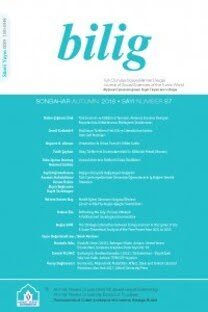Türki Cumhuriyetleri Öğrencilerinin Utangaçlık Düzeylerini Etkileyen Faktörler: Gazi Üniversitesi Örneği
Bu araştırmanın amacı, Türki Cumhuriyetlerden gelen ve Türk Üniversitelerinde eğitim gören üniversite öğrencilerinin utangaçlıklarının önemli yordayıcılarını belirlemektir. Korelasyonel türden bir çalışma olan bu araştırma Gazi üniversitesinde okuyan 135 öğrenciyi kapsamaktadır. Veriler, Utangaçlık Ölçeği, UÇLA Yalnızlık Ölçeği ve Coopersmith Benlik Saygısı Envanteri ve Geliştirilen Kişisel Bilgi Formu ile elde edilmiştir. Öğrencilerin utangaçlıklarını açıklamada çoklu regrasyon analizi kullanılmıştır. Araştırma bulguları, üniversite öğrencileri için özsaygı ve algılanan akademik başarı durumunun; utangaçlığın önemli yordayıcıları olduğunu göstermiştir.
Anahtar Kelimeler:
Türkiye
The Factor that Affect the Shyness Levels of University Students Coming from Turkic Republics
The purpose of this study is to determine the important indicators of shyness of university students. The study is an experimental type and it consists 135 students who continue to Gazi University. The data in this study was collected by using in this study; the shyness levels of high school students were examined with, mother education level, father education level, perceived academic success, self-esteem and loneliness variables. "Shyness Scale", self-esteem levels "Coopersmith Self-Esteem Inventory", and loneliness levels "UCLA Loneliness Scale" and Individual information Form that was developed by the researcher. In analyzing data related to students' shyness, multi-regression was used. Finding has indicated that self-esteem and perceived academic achievement are important indicators of shyness.
Keywords:
Turkey,
___
Arends, T. (2000), Understanding Shyness. Araneum Nostrum Panic/Anxiety Ring. [http:// members.aol.com/cybernettr/shyness.html#anchord 131942],Booth, R., D. Bartlett & J. Bohnsack (1992), An Examination of the Relationship Between Happiness, Loneliness and Shyness in College Students. Journal of College Student Development, 33 (2), 157-162.
Briggs, R. S. (1988), Shyness: Introversion or Neuroticism? Journal of Research in Personality, 22, 290-307.
Bullock, R.J. (1993), Children's Loneliness and Their Relationships with Family and Peers. Family Relations, 42 (1), 46-49.
Büyüköztürk, Ş. (2002), Sosyal Bilimler İçin Veri Analizi El Kitabı: İstatistik, Araştırma Deseni SPSS Uygulamaları ve Yorum. Ankara: PegemA.
Carducci, J. B & Zimbardo, G.F. (1995) Are You Shy? Psychology Today, 28 (6), 34-46
Carducci, J. B. (2000), Shyness: The New Solution. Psychology Today, 33 (1), 38-46.
Cheek, M.J. & Buss, H.A. (1981), Shyness and Sociability. Journal of Personality and social Psychology, 41 (2), 330-339.
Crozier, W.R. (1990), Shyness and Embarrassment. Perspectives From Social Psychology. Cambridge: Cambridge University Press.
Demir, A. (1990), UCLA Yalnızlık Ölçeğinin Geçerlik ve Güvenirliği. Psikoloji Dergisi. 1 (23), 14-18.
Enç, M. (1980) Ruhbilim Terimleri Sözlüğü. Ankara: Türk Dil Kurumu Yayını
Gard, C. (2000), How To Overcome Shyness. Current Health, 2, 27 (1), 28-30.
Goswick, R.A & Jones.W.H. (1982), Components of Loneliness During Adolescence. Journal of Youth and Adolescence, 11, 373-383.
Gökçe, S. (2001), Lise Öğrencilerinin Utangaçlık Düzeylerinin Yordanması. Yayınlanmamış Yüksek Lisans Tezi. Ankara: Gazi Üniversitesi. EBE.
Güngör, A. (2001), Utangaçlık Ölçeğinin Geliştirilmesi Geçerlik ve Güvenirlik Çalışmaları. Türk Psikolojik Danışma ve Rehberlik Dergisi, 2 (15), 17-22.
Henderson, L & Zimbardo, F.G. (1998), Syness. Encyclopedia of Mental Health . San Diego: Academic Press.
Hyson, CM & Trieste, K.V. (1987), The Shy Child. ARC Professional Services Group (ERİC Processing and Reference Facility). ED: 295741
Jackson, T, Fritch, A. & Gunderson, J. (2002), Toward explaining the associating between shyness and loneliness: A Path analysis with American college students. Social Behavior and Personality. 30 (3). 263-270.
Jackson, T., Flaherty, S.R & Kosuth, R. (2000), Culture and Self Presentation as Predictors of Shyness Among Japanese and American female College Students. Perceptual and Motor Skills, 90 (2), 475-482.
Johnson, J.M. & Petzel, T.P. (1991,) Attributions of Shy Persons in Affiliation and Achievement Situations. Journal of Psychology Interdisciplinary & Applied 125 (1), 51-59, 3 chart.
Jones, W.H., Briggs, S.R & Smith, T.G. (1986), Shyness: Conceptualization and Measurement. Journal of Personality and Social Psychology, 51 (3), 629-639.
Kağıtçıbaşı, Ç. (1998), Kültürel Psikoloji: Kültür Bağlamında İnsan ve Aile. İstanbul: YKY.
Kamath, M. & Kanekar, S. (1993), Loneliness, Shyness, Self-esteem and extra-version. Journal of Social Psychology, 133 (6), 855-858.
Kemple, M. K. (1995). Shyness and Self-Esteem in Early Childhood. Journal of Humanistic Counseling, Education & Development, 33 (4) 173-183.
Laam, H. & Stephan, E. (1987), Loneliness Among Germen University: Some Correlates. Social Behavior and Personality, 15 (2), 161-164.
Page, M. R. (1989), Shyness as a Risk Factor for Adolescent Substance Use. Journal of School Health, 59, 432-435.
Paulhus, D. L, Duncan, J. H, & Yik, MSM. ( 2002), Patterns of shyness in the East Asian and European-heritage. Journal of Research in Personality. 36 (5) 442-462.
Peplau, L.A & Perlman, D. (1982), Perspectives on Loneliness. (Ed: L.A. Pepfau & D. Perlman) A Sourcebook of Current Theory, Research and Therapy. New York: Wiley..
Pişkin, M. (1997). Türk ve İngiliz Lise Öğrencilerinin Benlik saygısı Yönünden Karşılaştırılması (21-35). 3. Ulusal Psikolojik Danışma ve Rehberlik Kongresi Kitabı. Adana: Çukurova Üniversitesi yayını.
Stevens, J.A. (1997), Utangaçlığınızı Yenin (Çeviren: Güider Tümer) Ankara: HYB Yayıncılık.
Yüksel, G. (2002), Üniversite Öğrencilerinin Utangaçlık Düzeylerini Etkileyen Faktörler Gazi Eğitim Fakültesi Dergisi. Cilt 22.(3), 37-57. Ankara: GEF yayını
Zimbardo, G.P. (1977), Shyness: What is it and what to do about it. Reading, MA: Addison-Wesley Publishing Company.
- ISSN: 1301-0549
- Yayın Aralığı: Yılda 4 Sayı
- Başlangıç: 1996
- Yayıncı: Ahmet Yesevi Üniversitesi Mütevelli Heyet Başkanlığı
Sayıdaki Diğer Makaleler
Isparta İl Merkezi'nde Bulunan Türbeler
FİLİZ NURHAN ÖLMEZ, Şirin GÖKMEN
Osmanlıda Toplumsal Dinamizmden Celali İsyanlarına Giden Yol ya da İki Belgeye Tek Yorum
Etkin Öğrenmede Yeni Arayışlar: İşbirliğine Dayalı Öğrenme ve Buluş Yoluyla Öğrenme
Türkiye'de Sınıf Öğretmeni Yetiştirme Politikaları ve Sorunları
Locke on Liberty and Necessity
Dil Ölümü Bağlamında Kayseri'de Yaşayan Uygur Türk Toplumu
"Sır Derya" Havzasının Türk Tarihindeki Yeri ve Önemi
KOBİ'lerde Bilgi Yönetimi Süreci ve Araçları: Literatür Değerlendirmesi ve Bir Araştırma
